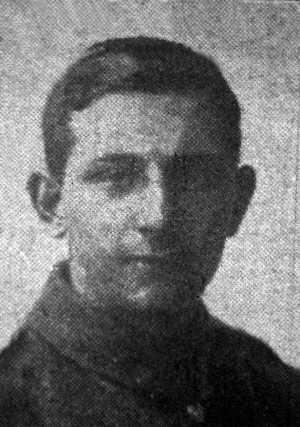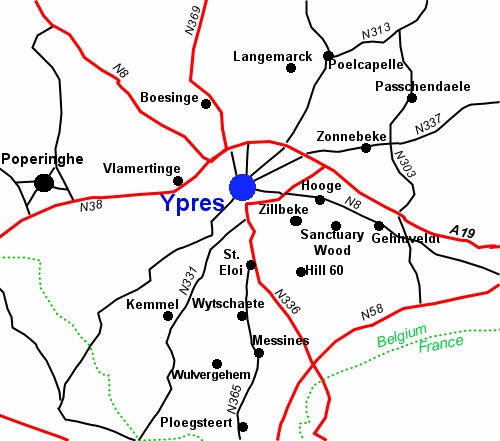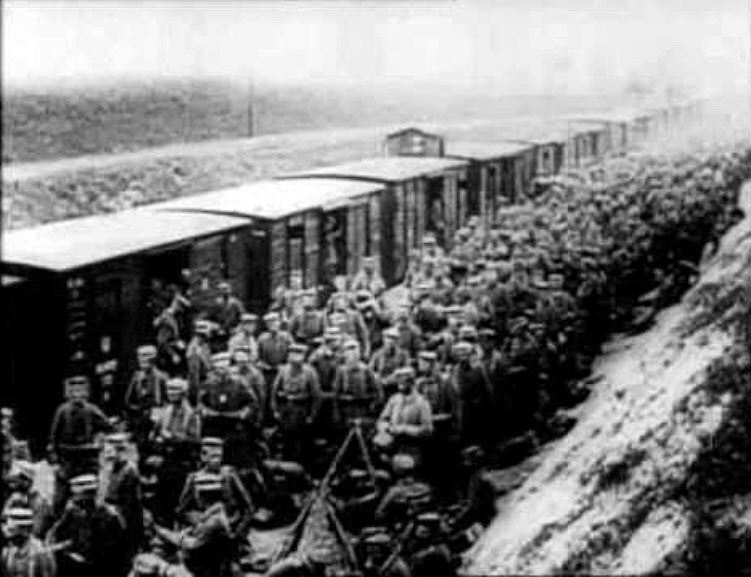
Edward Teale was born in Ossett on the 3rd of May 1898, the son of Eli Teale and Edna (nee Morton), who married in 1897. Edward was baptised at the Primitive Methodist Chapel, South Ossett on the 21st May 1898 and in 1901 he was living with his parents and a sister, Mary, aged 6 months, at Station Road, Ossett. Eli was working as self-employed tailor.
In 1911, the family are living at number 48, Station Road, Ossett. Eli Teale, a tailor works from home and his two children are at school. In the March quarter of 1913, the couple have another child, Rowland M. Teale.
Edward Teale, aged 18 years and 2 months, a football stitcher by trade, enlisted at Ossett on the 13th of July 1916. He was examined and passed fit for service at Pontefract on the 29th November 1916. Edward was 5’4” tall and weighed 112 lbs with a 33” chest measurement. On the 26th January 1917, the Army received a supportive reference for Edward from his employers, J. Clegg & Son, Athletic Goods Manufacturers of Ossett. The reference indicated that Edward had worked for the business for 4¾ years. On the 29th January 1917, he joined the 84th Training Reserve Battalion and was allocated the Regimental number TR/5/58233.
After the 1st of September 1916, regimental distinctions disappeared and the reserve units of the regiments were instead redesignated as battalions of the Training Reserve. They were organised into new brigades. Men who were posted to the TR battalions were not allocated to any particular regiment when the time came for them to be posted. Each battalion was allocated a block of 4000 numbers. The standard form for a number was “TR/the number of the District in which the Record Office of the unit was (there were 12 such Districts)/the man’s unique number”. 1
On the 23rd of April 1917, Edward was at the 84th Battalion’s Base at Hornsea where he scored a class 1 marksman grade in musketry. By May 1917, the battalion moved to Catterick and became dedicated to receiving recruits who would be allotted to the Machine Gun Corps, although this change came too late for Edward. He embarked from Folkestone with the British Expeditionary Force on the 25th September 1917, disembarking at Boulogne.
On the 26th September, at Etaples, he was transferred to the Durham Light Infantry (D.L.I.) and on the 6th October 1917, he was posted to the 19th Battalion D.L.I. with the regimental number 44863, and joined their billet at Buire, east of Perrone in France. The 19th Battalion the Durham Light Infantry were in the 106th Brigade of the 35th Division until February 1918, when they transferred to 104th Brigade, but still in 35 Division.

On the 13th October 1917, the 35th Division entrained north to the west of Ypres and on the 16th October Edward experienced his first tour of the front line near Ypres, Belgium where the 35th Division took part in the Third Battle of Ypres. The 106th Brigade fought in the advance on Houthhulst Forest but the 19th Durham’s were largely held in reserve until the 24th October when they successfully led the line against heavy artillery and machine gunfire from an enemy raid of 400 men.
Ypres was a town of relatively little strategic importance, but of great significance in that it was fought over practically throughout the whole of the war. Once again, there was high ground which dominated this battlefield, out to the north, south and east of the town. After the retreat from Mons, the First Battle of Ypres was fought in October/November 1914. Following this brief period of warfare of movement, trenches were dug in and the area around Ypres ended up in late 1914 as a large salient, or part of the line where the trenches of one side jutted out into enemy territory. Salients were difficult to defend, as they were vulnerable to fire from three sides.
There was fighting around the town for the next four years, until at last during 1918, firstly the Germans pushed forwards in their Spring Offensive (operation Michael), and then the British drove them back. During their advance, the Germans never quite reached Ypres, as the various Demarcation stones around the region, including at Hellfire Corner, just outside Ypres on the Menin road. Throughout the War, the Allies were determined to hold onto Ypres, and despite fierce attempts to take it, they did.
In early November at Poelcapelle, near Ypres, the 19th Durhams suffered severely from intense enemy bombardment with gas and heavy shell causing the loss of 13 officers and 125 men, most of whom were gassed. In October and November 1917 the 19th Battalion the Durham Light Infantry losses were 41 killed and 240 wounded which was more than 25% of the battalion strength. A quiet December 1917 and early January 1918 saw no 19th Durham casualties during a period of rest, refitting, training and spasmodic work for the Royal Engineers near Houtquerque, north west of Ypres.
Another Ossett man, Bennett Brook of Sowood Farm, also served with the 35th Division, in the 106th Brigade Machine Gun Company. Bennett Brook kept a War Diary which includes his service in France between 1st January 1918 and 28th May 1918 when he was ‘marked back to Blighty’ suffering from trench fever.
It is not known whether Edward Teale, of Station Road, and Bennett Brook, of Sowood Farm, were friends before the War but the diary records several occasions in Belgium, and later in France, when they met up. Being in the same 35th Division and the same Brigade meant that they would never be far apart when in combat but their billets were often not in the same location. The Ypres landscape of thick mud, shell holes and, not least, the enemy did not encourage easy passage in any circumstances.
Bennett Brook’s Diary began on 1st January 1918, although Bennett served in France from about the time that Edward Teale embarked on 25th September 1918. In December 1917 and January 1918 the 104th and 106th Brigades were billeted less than two miles apart and 15 miles to the west of Ypres, well behind the front line and out of harm’s way so there were several occasions when the two men met up.
The very first entry in Bennett’s Diary records:
After marching from billets to Proven the 35th Division entrained 10 miles due east to Boezinge, on 8th January 1918 the 106th Brigade was in the line east of Poelcapelle, 8 miles north east of Ypres. This pattern of several days in the line and several days at rest and on relief continued throughout the remainder of January, the whole of February and to mid March 1918. In the most appalling cold wet weather, ground conditions and hostile artillery, attack and counter attack. No real progress was made by the allies or the enemy. On the 8th February 1918, the 19th Battalion, Durham Light Infantry transferred from the 35th Division, 106th Brigade to the Division’s 104th Brigade.
In a lull in proceedings Edward and Bennett were able to meet on only two occasions when they were in billets near Woeston:
By mid-March 1918, it was apparent that the Germans were transferring troops from the Eastern (Russian) front to deploy them on the Western Front, most probably between Cambrai and the Somme in France. On the 21st March, the 35th Division entrained south to reinforce this line and repulse what would later be known as the ‘German Spring Offensive’. The 104th Brigade left Peselhoek Belgium for the Somme area in France on the 23rd March and shortly thereafter the 19th Durhams were in support near Maricourt, repelling the enemy’s offensive, which was driving the Allies westwards.

Above: German troops fresh from the Eastern Front after the Russians ceased fighting entraining in France in March 1918 for the German Spring Offensive.
The 35th Division casualties during this week in March 1918 amounted approximately to 90 officers and 1450 men. The 19th Durham Light Infantry losses in March 1918 were 39 killed, 109 wounded, 21 missing. By comparison, the 19th Durhams had 33 men killed in July 1916.
During March to June 1918 the 104th Brigade, including the 19th Durham Light Infantry, were heavily involved in attempts to hold the line and repel the Spring Offensive. Amidst mustard gas shells, heavy artillery, machine gun fire and active aeroplane activity by the enemy and the British, defensive stands were made at Maricourt, Treux on the River Ancre, and later at Aveluy Wood in May until mid June 1918. The May and June 1918 casualties for the 19th Durham Light Infantry amounted to 9 killed and 81 wounded several of whom were gassed.2
In mid-May 1918, Edward Teale and Bennett Brook met for the last time as Bennett’s Diary records:
On these days Edward Teale and Bennett Brook were in billets at Toutencourt. In late June 1918, there were rumours of a new German Offensive in the north and on the 1st July the 35th Division moved back to Ypres in Belgium, which they had left behind in mid-March 1918. For most of July, the 19th Battalion, Durham Light Infantry were in support and in the front line, largely without incident, relieving, and being relieved by their 104th Brigade companions, the regiment of the 17th Lancashire Fusiliers.
On the 27 July at 11.30p.m., the Battalion’s Regimental War Diary records a raid in the following terms:
“The Battalion carried out a raid on the enemy trench on the left of Locre Hospice. The raiding party consisted of 28 other ranks (O.R.) from ‘X’ Company under Captain Smith M.C. and Captain J.W. Ryall and 32 O.R. from ‘Z’ Company under 2nd Lieutenants W.G. Dyer M.C. and Jordan supervised by Capt. H. Heaton M.C. A most accurate 3 minute Stokes Barrage was put down on the enemy line and an 18lbs barrage on our S.O.S. line. At Zero + 3 the raiders went over and entered the enemy trench at two different points, the wire being cut by Bangalore Torpedoes. An unusual number of the enemy were found in the trench an a large number were killed. Two wounded prisoners and a machine gun were brought back to our lines. Capt Ryall & 2nd Lts. Dyer & Jordan were wounded (the latter two officers very slightly) and 21 O.R. wounded. Most of the casualties were caused by bombs and mostly slight. Identification showed the (enemy) line was held by . The Brigadier wired ‘WELL DONE DURHAMS’.”
The Machine Gun was brought back by the seriously wounded Captain Ryall with the assistance of his servant. None of the Durhams were killed, although twenty ‘other ranks’ were wounded. In addition to those enemy overcome in the hand-to-hand fighting, about fifty more were killed, probably by the barrage. It is believed the enemy were in the process of a relief or preparation for an attack. The following day, the 19th Durhams were relieved from the front line, and on the 31st July they moved to Camp near Terdeghem. In July 1918, battalion casualties were three officers and twenty ‘other ranks’ wounded.
By 5th August the enemy appeared to be showing signs of retreat, but on the 7th August two patrols of the 19th Durhams encountered the enemy at strength further in the rear, and showing no inclination to move. On Sunday 11th August, His Majesty the King attended a Parade near Terdeghem and by the end of August it was becoming evident that the enemy was withdrawing from parts of the Ypres Salient after heavy losses of men in recent actions.
In early September 1918, the Durhams moved to billets at Herzeele and into Battalion Reserve east of Poperinghe, interchanging positions in the line with the 15th Sherwood Foresters and 17th Lancashire Fusiliers. From the 13th September onwards, in the region of Hill 60, there was a noticeable increase in hostile activity, with the Durhams capturing five enemy from the hitherto unknown 40th Saxon Division. Over the next few days a further 49 prisoners and two machine guns were captured from the same enemy division, which appeared demoralised and in poor condition.
On the 15th September, the line was advanced 1000 yards near Zillebeke by the 19th Durhams and the 18th Lancs Fusiliers. On the 28th of September 1918, the battalions took their positions between 2 and 3 a.m. and the barrage opened at 5.25a.m. At Zero hour + 5, as rain fell, what turned out to be the final advance began as the 19th Battalion Durham Light Infantry attacked the enemy lines and took Hill 60. The Lancashire Fusiliers took the advance further to Zandvoorde where the 19th Durhams were located on the night of the 29th September. Many enemy prisoners, two field guns, seven trench mortars and 22 machine guns were captured during the advance.
On the 30th September 1918, the Durhams were ordered to advance to the Gheluwe Switch between Wervicq and Gheluwe. They marched through Tenbrielen and attacked at 7 p.m. before being held up by heavy machine gun fire and barbed wire entanglements. In this sector, the 35th Division had now reached the most easterly point achieved by the British on 19th October 1914. Further advances took the 35th into virgin territory and open warfare as the trenches were left behind them. At nightfall on the 30th September, the 104th Brigade Battalions of the 19th Durhams and 18th Lancashire Fusiliers stood on the ground gained and the Brigade began its advance at dawn.
The Durham’s Regimental War Diary for the 1st October 1918, on the day that Private Edward Teale was killed in action reads:
“Attacked the Gheluwe Switch but only advanced about 200 yards. Held up by a strong line of pill boxes, entanglements and heavy machine gun fire. Relieved by 17th Lancashire Fusiliers and moved into support under very heavy bombardment.”
Little progress was made in the early morning due to heavy enemy machine gun fire near to Gheluwe Switch, a strong line of trenches and pill boxes had been constructed twelve months previously to cover nearby Menin. It is probable that 20 year-old Edward Teale was killed here, in the attack on the enemy pill boxes or in the subsequent relief operation. The 105th and 106th Brigades of the 35th Division were present but unable to take part in any serious action due to shortage of men. On the 28th September their respective trench strengths were 2280 and 2050 but were now only 900 and 500 strong.
The “Ossett Observer” 3 had this obituary for Private Teale:
“Well-Known South Ossett Man Killed – Signaller Edward Teale (20), Durham Light Infantry, son of Mr. and Mrs. Eli Teale, 48, Station-road, Ossett, must be added to the long list of local heroes who have sacrificed their lives in the war. The deceased was a young man, full of promise. At the time he joined the forces, he was assistant secretary and a teacher at the South-parade Primitive Methodist Sunday School, with which he had been associated with all his life, and was also a member of the choir. He worked for Messrs. J. Clegg and Son, athletic goods manufacturers, Park-square. It was in January 1917, that he went into the army, and he went out to France just over a year ago. In the fighting in the vicinity of Ypres, he was wounded in the left hand on Palm Sunday, and received hospital treatment at Boulogne. For several weeks his relatives and friends have been looking forward to his coming home on leave, but on Tuesday morning an official notice was received from the army authorities, stating that he was killed in action in France on October 1st.”
Edward Teale’s Army Service record indicates only that he suffered gun shot wounds to his left hand on an unspecified date in 1918 and that he was killed in action on 1st October 1918. Edward’s mother, Edna, subsequently received a separation allowance/ allotment of pay of 12/6d, which would not be paid beyond the 21st April 1919. Edward was also posthumously awarded the British and Victory Medals.
Private Edward Teale, died on the 1st October 1918, aged 20 years and he is buried at grave reference III. F. 29. at the Zantvoorde British Cemetery, 4 Zonnebeke, West-Vlaanderen, Belgium. Zandvoorde British Cemetery is located 8 Kms south-east of Ieper town centre, on the Kruisekestraat a road leading from the Meenseweg (N8), connecting Ieper to Menen.
On 30 October 1914, the village of Zantvoorde (now Zandvoorde) was held by the 1st and 2nd Life Guards, numbering between 300 and 400 men. It was bombarded for over an hour with heavy guns and then taken by the 39th German Division and three attached battalions. The whole front of the 3rd Cavalry Division was driven back to the Klein-Zillebeke ridge. The village could not be retaken and remained in German hands until 28 September 1918. The attack in which the village was taken was Edward Teale’s final action and, fittingly, this is his final resting place.
Zantvoorde British Cemetery was made after the Armistice when remains were brought in from the battlefields and nearby German cemeteries. Many were those of soldiers who died in the desperate fighting round Zantvoorde, Zillebeke and Gheluvelt in the latter part of October 1914.
There are now 1,583 servicemen of the First World War buried or commemorated in the cemetery. 1,135 of the burials are unidentified. Special memorials commemorate 32 soldiers buried in two of the German cemeteries whose graves could not be found on concentration. The cemetery also contains one Second World War burial.
References:
1. The National Archives Regimental War Diaries, series WO 95
2. “The History of the 35th Division In The Great War”, Lieutenant-Colonel H.M. Davison C.M.G., D.S.O., R.A.
3. “Ossett Observer”, 26th October 1918